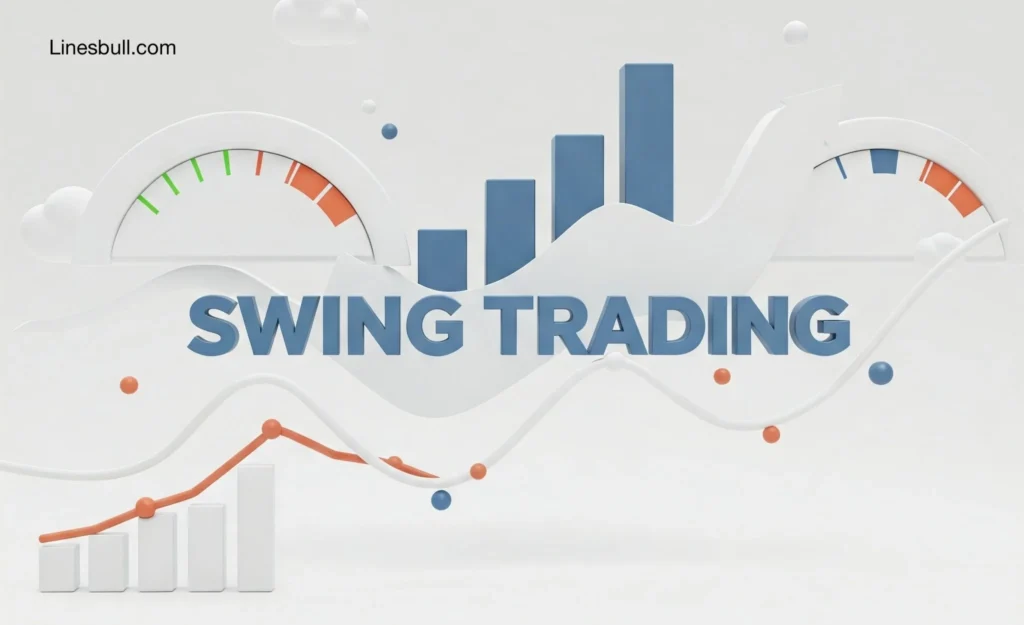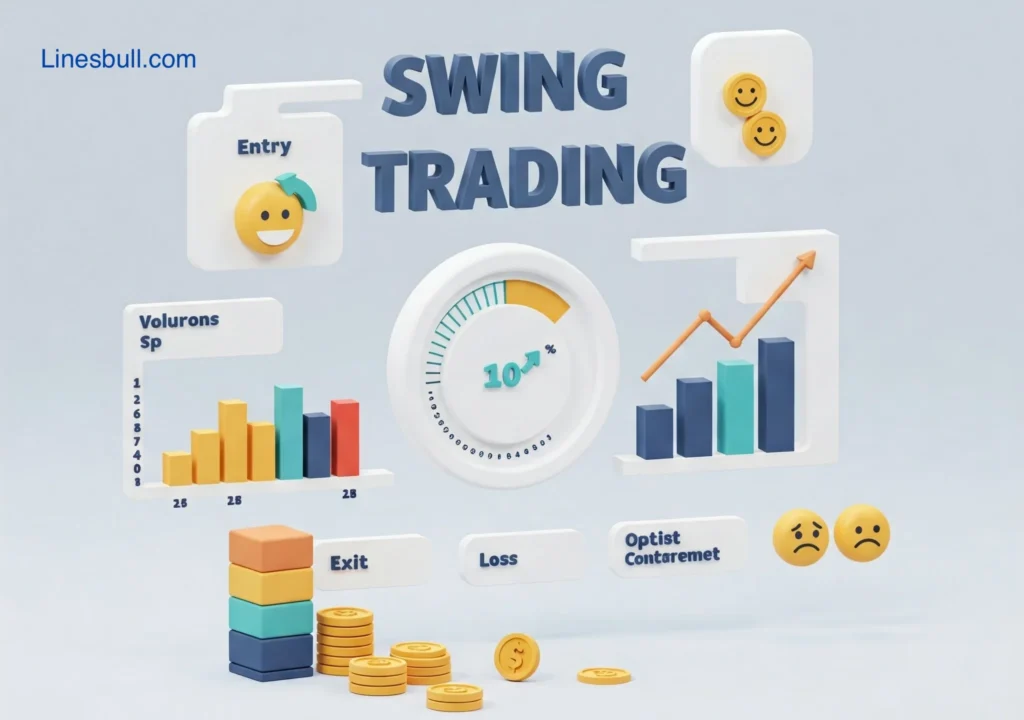Introduction
Let’s Start how does swing trading work? Swing trading is a popular trading strategy that allows traders to capitalize on short- to medium-term price movements in financial markets. It is commonly used in trading options and futures, offering opportunities to profit from market swings. But how does swing trading work? Let’s explore its fundamentals and strategies in detail.
What is Swing Trading?
Swing trading is a trading strategy that focuses on capturing short- to medium-term gains in financial markets. Unlike day trading, where positions are closed within a single trading day, swing traders hold their trades for several days or weeks to capitalize on market trends.
How Does Swing Trading Work?
Swing traders analyze charts and market trends to identify entry and exit points. They use technical indicators such as moving averages, RSI, and MACD to forecast price movements. The goal is to capture price swings, whether bullish or bearish, and make profits accordingly.

Swing Trading in Options
Options trading provides leverage, allowing traders to control large positions with smaller capital. Swing traders use call and put options to profit from price movements without owning the underlying asset. However, options trading carries inherent risks, including time decay and volatility.
What Are Options and How Do They Work?
Options are financial derivatives that give traders the right (but not the obligation) to buy or sell an asset at a predetermined price before a specific expiration date. Traders use options in swing trading to hedge against risks or leverage potential profits.
Swing Trading in Futures
Futures contracts allow traders to speculate on the price of assets like commodities, currencies, and indices. Swing trading in futures involves taking advantage of price swings within the contract period. The leverage in futures trading can amplify gains but also increase risk.
What Are Futures and Their Role in Swing Trading?
Futures are standardized contracts to buy or sell an asset at a fixed price on a future date. Futures trading in swing trading allows traders to speculate on price movements and take advantage of leverage to maximize profits.
Comparison: Swing Trading vs. Day Trading
| Feature | Swing Trading | Day Trading |
|---|---|---|
| Holding Period | Few Days to Weeks | Within the Same Day |
| Capital Required | Moderate | High |
| Risk Level | Moderate | High |
| Time Commitment | Less Intensive | Full-Time Activity |
How Swing Trading Works in Options & Futures
The Concept of Holding Positions for a Few Days to Weeks
Swing traders typically enter positions when they identify potential price trends, holding them for a few days to weeks before exiting at a targeted profit level.
Swing Trading Strategies for Options Traders
- Buying Call and Put Options based on trend analysis
- Utilizing credit and debit spreads for risk control
- Selling covered calls for additional income
Swing Trading Strategies for Futures Traders
- Trading on breakouts with stop-loss placements
- Using trend-following techniques to catch market swings
- Leveraging futures contracts with risk-reward balancing
Technical Indicators for Swing Trading

Moving Averages (MA & EMA)
Moving averages help traders identify trends by smoothing out price fluctuations over time.
Relative Strength Index (RSI)
RSI measures momentum and identifies overbought or oversold conditions in the market.
MACD and Stochastic Oscillator
These indicators help determine the strength of a trend and potential reversal points.
Other:
- Moving Averages
- Relative Strength Index (RSI)
- Bollinger Bands
- Fibonacci Retracement
- MACD (Moving Average Convergence Divergence)
Comparison: Swing Trading vs. Long-Term Investing
| Feature | Swing Trading | Long-Term Investing |
|---|---|---|
| Time Horizon | Short to Medium Term | Years to Decades |
| Active Management | Required | Low |
| Risk Factor | Moderate to High | Lower Risk |
| Profit Potential | Higher in Short Term | Stable in Long Run |
Pros and Cons of Swing Trading in Options & Futures
Advantages of Swing Trading
- Requires less time than day trading
- Higher profit potential with leverage
- Suitable for various asset classes
Risks and Challenges
- Market volatility can impact trades
- Requires careful risk management
- Leverage can amplify losses
Advantages and Disadvantages of Swing Trading in Options & Futures
| Aspect | Pros | Cons |
|---|---|---|
| Potential Returns | Higher profit potential compared to day trading due to larger price swings. | Higher risks as market gaps can lead to significant losses overnight. |
| Time Commitment | Requires less screen time compared to day trading, making it suitable for part-time traders. | Still requires active monitoring and analysis to capitalize on opportunities. |
| Leverage in Futures & Options | Allows traders to control large positions with a smaller capital investment. | High leverage increases the risk of amplified losses if trades go against the trader. |
| Flexibility | Works well across various asset classes like stocks, commodities, and indices. | Requires deep market knowledge to apply effectively in different instruments. |
| Technical Analysis-Based Strategy | Beneficial for traders skilled in reading charts, trends, and indicators. | Technical indicators can sometimes give false signals leading to losses. |
| Holds Positions Overnight | Traders can benefit from overnight market movements and gaps. | Exposure to after-hours volatility and news events that can drastically change trade outcomes. |
| Lower Transaction Costs | Compared to day trading, swing traders face fewer transaction fees and commissions. | Spreads and margin interest on leveraged positions can still be costly. |
| Less Psychological Stress | Reduces the emotional toll of minute-to-minute market fluctuations. | Holding positions for multiple days can lead to uncertainty and stress. |
| Profitability in Trending Markets | Ideal for capturing medium-term trends in the market. | Less effective in choppy, sideways markets where no clear trend exists. |
| Requires Sound Risk Management | Proper stop-loss strategies can minimize risks and protect capital. | Poor risk management can quickly lead to large drawdowns or account wipeout. |
| Less Frequent Trading | Allows more time for analysis and strategic entries. | Fewer trading opportunities may limit potential earnings compared to scalping or day trading. |
| Capital Requirements | Can start with a relatively small capital base, especially in options trading. | Futures trading often requires a larger account size due to margin requirements. |
| Trend Identification Skills | Can take advantage of short-term momentum in trending markets. | Requires strong technical knowledge to avoid mistimed entries and exits. |
| Earnings Consistency | Can generate consistent returns when executed with discipline and proper strategy. | Returns can be inconsistent due to market fluctuations and unforeseen events. |
| Market Liquidity Considerations | Trading highly liquid options and futures contracts ensures smooth order execution. | Low liquidity contracts can have wide bid-ask spreads, leading to slippage and higher costs. |
Risk Management in Swing Trading
Managing risk is crucial in swing trading. Traders use stop-loss orders to limit potential losses. Position sizing and maintaining a proper risk-reward ratio are essential to long-term success.
Psychology of Swing Trading
Successful swing traders maintain discipline, patience, and emotional control. The ability to stick to a trading plan and avoid impulsive decisions separates profitable traders from unsuccessful ones.
Best Practices for Successful Swing Trading
- Develop a well-structured trading plan
- Stay disciplined and avoid emotional trading
- Keep track of market news and economic events
Common Mistakes in Swing Trading
- Overtrading and excessive risk-taking
- Ignoring market conditions
- Failing to use stop-loss strategies
Best Markets for Swing Trading
Swing trading works well in:
- Stock Market
- Forex Market
- Commodity Markets (Gold, Oil, Silver)
Conclusion
Swing trading in options and futures provides an excellent opportunity for traders looking to capitalize on market swings. While it requires market knowledge, risk management, and discipline, the rewards can be significant. How does swing trading work? It’s all about identifying market trends, executing trades strategically, and managing risks effectively.
FAQs
What is the ideal holding period for swing trading?
Swing trading typically involves holding trades for a few days to a few weeks, depending on market conditions.
Is swing trading in options riskier than futures?
Options carry expiration risks, while futures involve margin requirements. Both have risks but differ in their complexity.
How much capital do I need for swing trading?
The capital needed depends on the asset and risk management strategy. Futures require margin accounts, whereas options need premium payments.
Can beginners start with swing trading?
Yes, beginners can start swing trading with proper education, risk management, and a solid strategy.
What are the best indicators for swing trading?
Popular indicators include Moving Averages, RSI, MACD, and Stochastic Oscillator.


